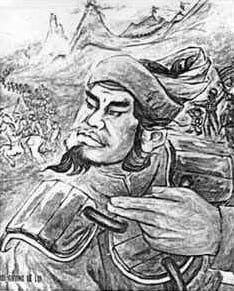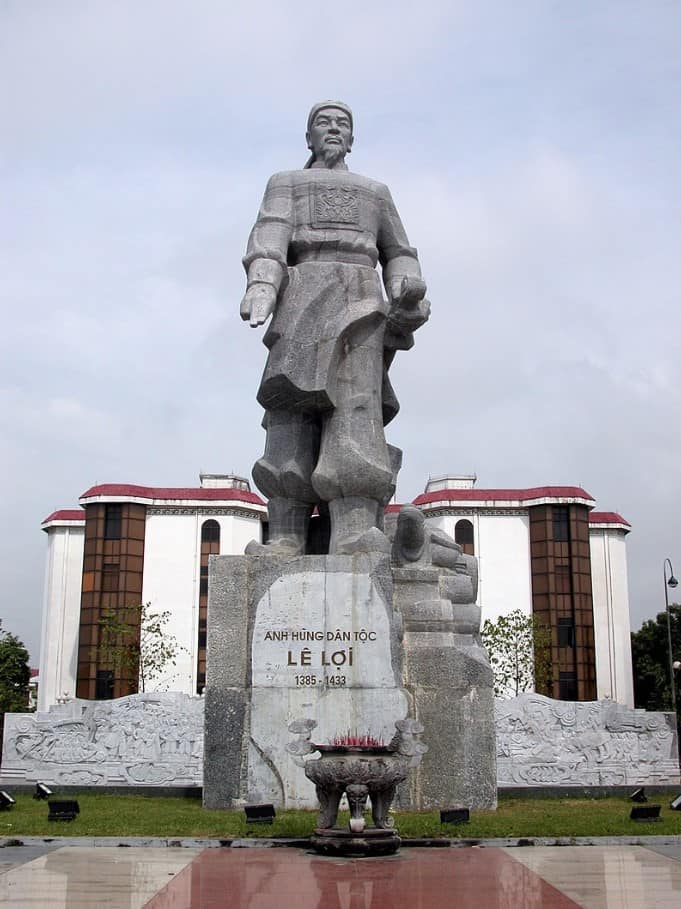Thuận Thiên Sword: Myth and Might in Lê Lợi’s Hands
TLDR: The Thuận Thiên Sword, a mythical weapon of Vietnamese Emperor Lê Lợi, was pivotal in liberating Vietnam from Ming rule. Legend says it possessed magical powers, aiding Lê Lợi in battle.
The story of the Thuận Thiên Sword is one that captivates the imagination, weaving together history and legend in a way that feels almost magical. This legendary sword, associated with Lê Lợi during the resistance against the Ming dynasty, is not just a weapon; it’s a symbol of hope and resilience for the Vietnamese people. I find it fascinating how this sword is said to have been gifted by the Dragon King, adding an enchanting layer to its narrative.
Legend of the Thuận Thiên Sword
The legend of the Thuận Thiên Sword is steeped in myth and history, intertwining the narrative of Lê Lợi’s resistance against the Ming dynasty with elements of Vietnamese folklore. According to the legend, the Thuận Thiên Sword, which translates to “Heaven’s Will,” was not just an ordinary weapon; it was said to possess magical powers that aided Lê Lợi in his quest for liberation. The origins of the sword are shrouded in mystery, with tales suggesting that it was a divine gift from the Dragon King, who recognized Lê Lợi’s noble cause and decided to lend him this powerful artifact.
The Dragon King’s involvement is central to the legend. It is said that he split the sword into two parts: a blade and a hilt, which were hidden until they could be reunited by Lê Lợi. This division symbolized both the challenges Lê Lợi faced and the eventual triumph that awaited him. The sword’s blade was discovered by a fisherman named Lê Thận, who repeatedly found it in his net despite his attempts to discard it. This persistence was interpreted as a sign from heaven, leading him to keep the blade without understanding its significance at first.
The hilt of the Thuận Thiên Sword was revealed to Lê Lợi during a moment of peril while he was fleeing from enemy forces. He noticed a strange light emanating from a banyan tree and discovered the hilt encrusted with gems. Recognizing its potential connection to the blade, he took it with him. When Lê Lợi later reunited with Lê Thận, they found that the blade and hilt fit perfectly together, marking a pivotal moment in their journey towards liberation.
Key elements of the legend of the Thuận Thiên Sword include:
- Divine origins linked to the Dragon King
- The division of the sword into blade and hilt
- Discovery by Lê Thận and subsequent events leading to its unification
- Symbolism of perseverance and destiny
| Element | Description |
|---|---|
| Divine Gift | The sword as a loan from the Dragon King |
| Discovery | Blade found by fisherman Lê Thận |
| Hilt Revelation | Found by Lê Lợi during flight |
| Unification | Blade and hilt fitting perfectly together |
As someone intrigued by historical legends, I find the story of the Thuận Thiên Sword particularly captivating. The blend of mythological elements with real historical figures like Lê Lợi creates a rich tapestry that speaks to both cultural identity and resilience. I often wonder how many other legendary artifacts exist in various cultures that similarly embody their people’s struggles and triumphs.
Physical Description of the Thuận Thiên Sword
The Thuận Thiên Sword, known as “Heaven’s Will,” is celebrated not only for its legendary status but also for its remarkable physical characteristics and craftsmanship. According to historical accounts and folklore, the sword is described as having a long, elegant blade that is both sharp and sturdy, designed for both slashing and thrusting. Its aesthetic features include intricate engravings and embellishments, which reflect the artistry of Vietnamese swordsmiths of the time. The hilt was often adorned with precious materials, further enhancing its beauty and significance as a royal weapon.
In terms of materials, the Thuận Thiên Sword was traditionally crafted from high-quality steel, which was essential for producing a blade capable of withstanding the rigors of battle. The forging process would have involved techniques that combined both strength and flexibility, allowing the sword to maintain a sharp edge while being resilient enough to endure combat conditions. Some accounts suggest that the sword may have incorporated elements of bronze or other alloys, enhancing its durability and effectiveness.
The craftsmanship of the Thuận Thiên Sword is significant not only for its functional attributes but also for its symbolic representation of Vietnamese culture. The meticulous attention to detail in its design reflects the skill and artistry of blacksmiths who were dedicated to their craft. The combination of beauty and functionality in the sword’s construction serves as a testament to the importance placed on weaponry in Vietnamese history, particularly during times of conflict.
Key characteristics of the Thuận Thiên Sword include:
- Long, elegant blade designed for versatility
- Intricate engravings and embellishments
- High-quality steel construction for durability
- Possible use of bronze or alloys in crafting
- Symbolic representation of Vietnamese craftsmanship
Role of the Thuận Thiên Sword in Battles
The Thuận Thiên Sword played a crucial role in several key battles during Lê Lợi’s campaign against the Ming dynasty, significantly impacting the outcome of the conflict. One of the most notable battles was the siege of Tây Đô, where Lê Lợi, armed with the Thuận Thiên Sword, led his troops against the fortified Ming positions. The sword was said to have granted him extraordinary strength and tactical insight, enabling him to devise effective strategies that outmaneuvered the larger Ming forces. This battle marked a turning point in Lê Lợi’s campaign, as it not only boosted the morale of his troops but also instilled fear in the hearts of their enemies.
Another significant engagement was the battle at Tốt Động, where Lê Lợi’s forces achieved a stunning victory against a much larger Ming army. Accounts suggest that during this encounter, the Thuận Thiên Sword’s legendary power inspired Lê Lợi and his men to fight with unparalleled courage and determination. The sword was often described as glowing during critical moments, which further fueled the belief among his soldiers that they were destined for victory. This psychological advantage played a vital role in their success, allowing them to capitalize on their guerrilla tactics and ambush strategies.
The effectiveness of the Thuận Thiên Sword against Ming forces is well-documented in historical accounts. Many soldiers believed that wielding the sword endowed them with supernatural abilities, which contributed to their unwavering resolve in battle. The sword’s reputation grew as tales of its effectiveness spread throughout the ranks of both Vietnamese and Ming soldiers. It became a symbol of hope for the Vietnamese people and a source of dread for their adversaries.
| Battle | Significance |
|---|---|
| Siege of Tây Đô | Turning point; boosted morale |
| Battle at Tốt Động | Stunning victory against larger forces |
| Overall Campaign | Symbolized hope and resistance |
Return of the Thuận Thiên Sword
The return of the Thuận Thiên Sword is a poignant moment in Vietnamese legend, symbolizing the conclusion of Lê Lợi’s struggle against the Ming dynasty and the restoration of peace in Vietnam. This event is famously associated with an encounter involving a golden turtle in Hoàn Kiếm Lake, a site that has become integral to the narrative surrounding the sword. According to legend, after Lê Lợi successfully liberated Vietnam and ascended to the throne, he was out on a dragon boat enjoying a peaceful day on the lake. Suddenly, a giant turtle surfaced, its shell gleaming like gold. The turtle addressed Lê Lợi, reminding him that the Thuận Thiên Sword had been lent to him by the Dragon King for a specific purpose: to reclaim his homeland. This moment marked a realization for Lê Lợi that the sword was not his to keep but rather a divine tool meant for a greater cause.
The significance of returning the sword to the Dragon King cannot be overstated. It represented not only an act of humility and respect for divine intervention but also a recognition of the transient nature of power. By returning the sword, Lê Lợi acknowledged that his victory was not solely due to his own strength but also thanks to the support of higher powers. This act reinforced his legitimacy as a ruler and solidified his connection with the people, who revered him as a hero. The lake where this encounter occurred was subsequently renamed Hồ Gươm, or “Lake of the Returned Sword,” which serves as a lasting reminder of this pivotal moment in Vietnamese history.
The circumstances surrounding the final disappearance of the Thuận Thiên Sword are steeped in mystery and intrigue. After being returned to the golden turtle, it is said that the sword vanished into the depths of Hoàn Kiếm Lake, never to be seen again. Some accounts suggest that a flickering light could still be observed beneath the water’s surface, hinting at the sword’s continued presence in spirit. The disappearance of such a powerful artifact adds an air of mystique to its legend, leaving many to wonder about its fate and reinforcing its status as a symbol of hope and resistance.
Key aspects of the return of the Thuận Thiên Sword include:
- Encounter with the golden turtle in Hoàn Kiếm Lake
- Significance of returning it to the Dragon King
- Circumstances surrounding its final disappearance
- Impact on Lê Lợi’s legacy as a ruler
- Transformation of Hồ Gươm into a national symbol
Conclusion
Reflecting on the tale of the Thuận Thiên Sword leaves me with a sense of wonder about its role in Vietnamese history. The idea that a sword could possess such significance, from its legendary origins to its dramatic return to the Dragon King, speaks volumes about the cultural heritage it represents. It’s fascinating to consider how such legendary weapons compare to other iconic blades, like the diverse types of Chinese swords, each with their own rich histories and cultural significance. Stories like these endure through generations, inspiring people to connect with their past.


